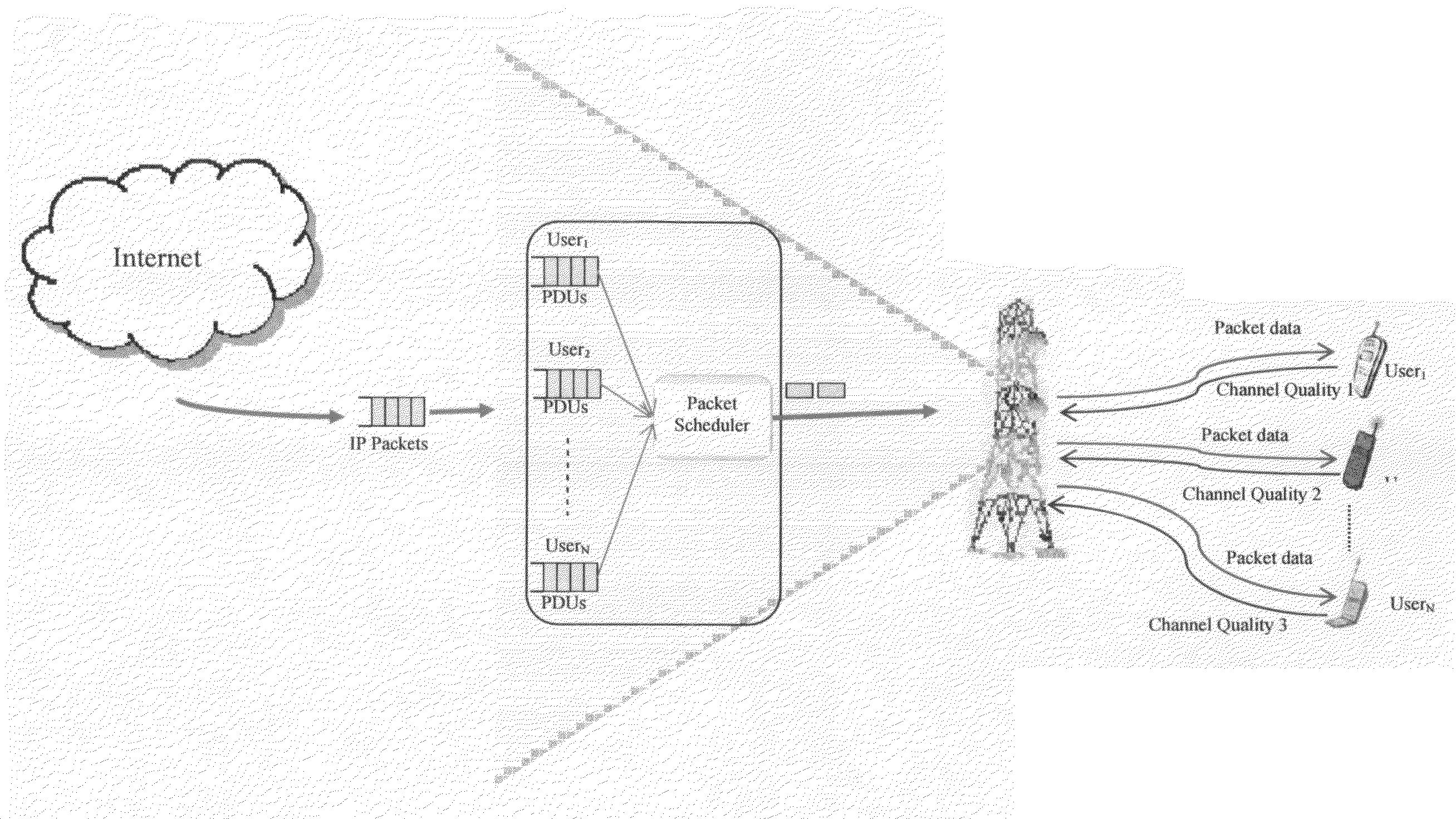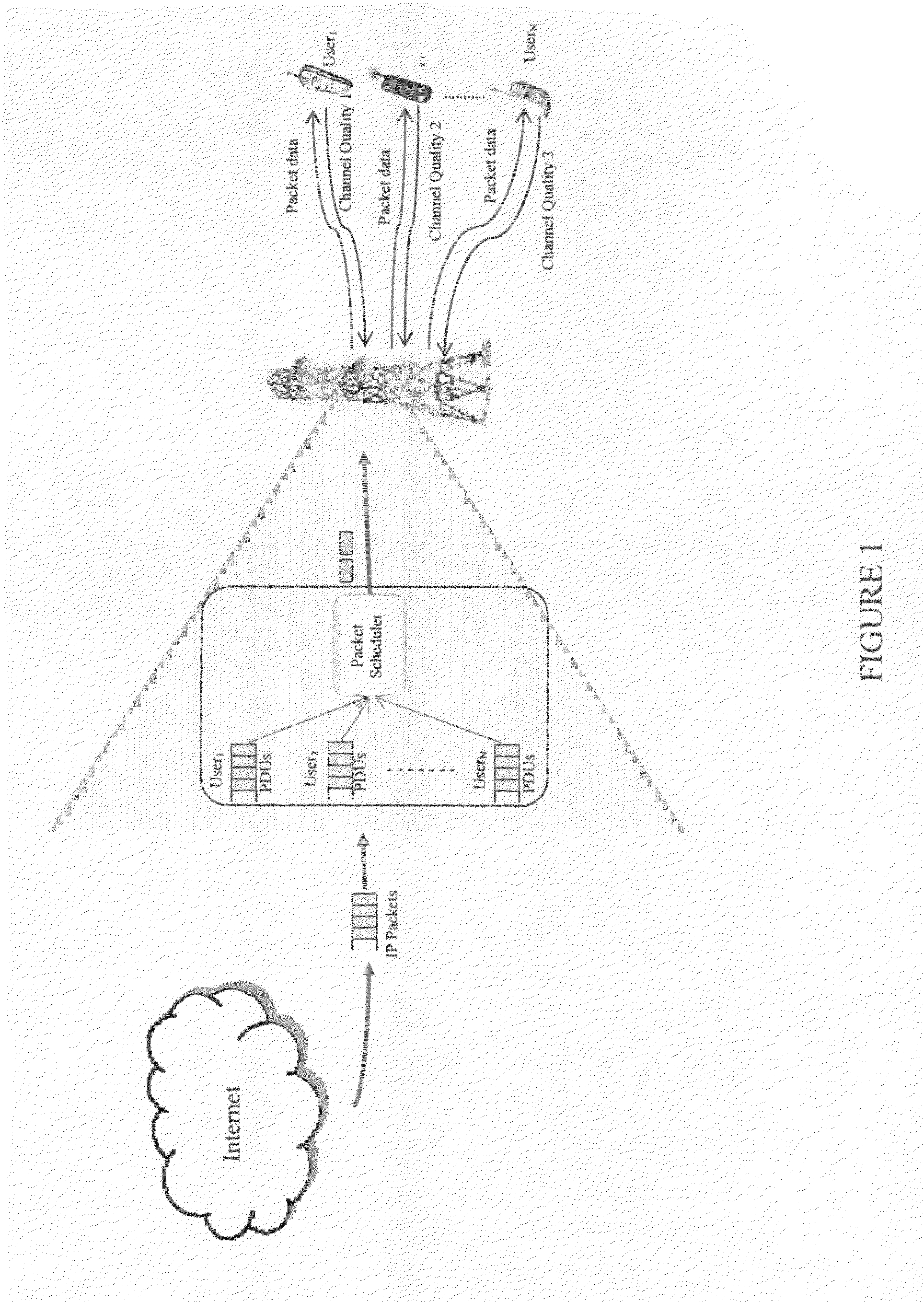Method for optimal packet scheduling for wireless and mobile communications networks
a wireless and mobile communication network and packet scheduling technology, applied in data switching networks, frequency-division multiplexes, instruments, etc., can solve the problems of increased opportunity cost to the service provider, increased opportunity cost of scheduling transmission for a user, etc., to achieve faster fairness, deterioration of channel quality conditions, and increased opportunity cost of scheduling transmission for one or more users
- Summary
- Abstract
- Description
- Claims
- Application Information
AI Technical Summary
Benefits of technology
Problems solved by technology
Method used
Image
Examples
working example
[0076]Performance of the UOC-PS was evaluated in a HSDPA network by means of dynamic discrete event simulation using Network Simulator (NS-2) [9] and its Enhanced UMTS Radio Access Network Extensions (EURANE) [10]. As mentioned above, HSDPA is a 3.5G wireless cellular system that was standardized as an extension to the existing 3G cellular system: UMTS. In HSDPA, a high-speed downlink data channel is shared by multiple users within the same cell to offer peak rates of 14.4 Mbps, 7 times larger than the data rate offered by UMTS. Packet scheduling plays a very important role in HSDPA since it determines how its high-speed downlink data channel is shared among users.
[0077]The architecture of the UMTS system and its extension will first be described. Then the simulation model and the channel model will be described.
UMTS Architecture
[0078]The network architecture of UMTS as shown in FIG. 4 consists of three main elements [10]: (i) User Equipment (UE), (ii) UMTS Terrestrial Radio Access ...
case 1
rian A (Ped A)
[0087]FIG. 6 compares the cell throughput of the evaluated algorithms for the Ped A environment with 25 users. The figure shows that the Max CIR algorithm achieved the highest cell throughput (2.1 Mbps). This was expected since the Max CIR algorithm only serves users at their best channel conditions at the expense of ignoring those with bad channel conditions. The cell throughput achieved by the UOC-PS with K=7.3 Mbps was slightly lower than the PF algorithm (1.4 Mbps compared to 1.56 Mbps). The reason for this is that the UOC-PS serves the users with low average throughputs more than the PF algorithm by giving them more time slots, so as to increase relative fairness and maximize the overall utility of the system. However, as K decreased to 3 Mbps (according to the above definition of the OC(i,t), the lower the value of K, the lower the fairness), the cell throughput increased from 1.4 Mbps to 1.85 Mbps. This is because when K=3 Mbps, only those with good channel cond...
case 2
Channel
[0090]The scheduling algorithms were evaluated in this environment based on average user throughput and percentage of packet loss. Seven values were used for the SNR: −7, −4, −1, 2, 5, 8, and 11 dB (i.e., the channel conditions of the users were fixed at these values). For each SNR value, there were 10 users (a total of 70 users in the cell). Results for each group of 10 users based on their SNR were collected. For example, the average throughput was computed for users with SNR=−7 separately from users with SNR=−4, etc. This demonstrates how the scheduling algorithms serve users with different channel conditions.
[0091]FIGS. 14 and 15 depict the users' average throughputs and the percentage of packet loss for users with different SNR values, respectively. Clearly, the UOC-PS achieved better performance in terms of user's average throughput and percentage of packet loss for users with low SNR values (e.g., −7, −4 and −1 dB). This is because of the effect of the fairness measure...
PUM
 Login to View More
Login to View More Abstract
Description
Claims
Application Information
 Login to View More
Login to View More - R&D
- Intellectual Property
- Life Sciences
- Materials
- Tech Scout
- Unparalleled Data Quality
- Higher Quality Content
- 60% Fewer Hallucinations
Browse by: Latest US Patents, China's latest patents, Technical Efficacy Thesaurus, Application Domain, Technology Topic, Popular Technical Reports.
© 2025 PatSnap. All rights reserved.Legal|Privacy policy|Modern Slavery Act Transparency Statement|Sitemap|About US| Contact US: help@patsnap.com



